Fresh from the International Garden Tourism Conference in South Korea, Linda Ross is in the Garden Clinic hot seat this weekend.
We're organising our orchids, pruning our native plants, mulching up for moisture retention and getting our gardens ready for summer. If you missed the show you can read up on what we talked about here, or listen to the podcast at 2GB.com.
The Zinnia gets Linda's 'happiest flower award' today.
It's time to:
In Temperate zones
Feed your orchids. Neutrog Strike Back for Orchids is excellent as they have plenty of nitrogen for strong leafy growth at this time. Apply fortnightly during November and December.
Lightly prune native plants to keep them from becoming sparse and woody. Prune callistemons to remove spent flowering spikes.
Apply a thick layer of mulch to garden beds to keep the soil cool and moist over the heat of summer and to discourage weeds. Choose a mulch that suits
your style of garden - leaf mulch is great for shrubberies and native gardens, sugar cane mulch, like Sweet Garden, or lucerne, like Major's Mulch pellets for perennial beds and the vegie patch, and ti-tree mulch for showy annual beds. You
may also use gravel or pebbles, especially on pot plants.
Planting this week
Plant your own tumeric now. It's great for your health and looks fab in a tropical-inspired garden. It is useful and incredibly attractive with it's white
Thai ginger flower.
In cooler climates
Mid November is a good time for planting summer and autumn flowering bulbs such as lilies, hippeastrums and gladiolus in the ground now.
Melbourne’s dry summers mean gardeners can be inspired by Mediterranean style and fill classic terracotta pots or hanging baskets with brightly coloured
red and pink geraniums. Plant now; impatiens and marigolds work well too.
Cut repeat flowering roses back by a third after each flush of flowers. They’ll be flowering on mass again in just 6 to 8 weeks. Time them to re-flower
for a summer garden party.
When you have an hour
Prepare the garden for summer. Check that watering systems are working efficiently and that there is adequate mulch on garden beds. Apply soil wetters,
such as EcoHydrate and Hydraflo2,
if soil is inclined to be water-repellent.
When you have 10 minutes
Set out lures to check for the presence of fruit fly. Lures trap the males and as soon as they are detected Eco Naturalure should be applied as directed to fruit trees to control female fruit flies. Replenish the
Eco Naturalure bait weekly through the fruiting season, and after rain.
Tip
When opening bags of manure or compost for the garden, put the bag in place and cut open with a blade or the sharp edge of a plant label, making the cut
at the bottom of the bag. This saves tipping the bag over to pour out the contents.
Bush Garden:
NSW Christmas Bush
This good-looking evergreen native shrub has three-pointed leaves and creamy flowers in spring. After flowering the NSW Christmas Bush calyxes turn a rusty red for a stunning Christmas show. They glow brightly in the
Eastern Australian bushland, and are easy to grow in the garden. ‘Albery’s Red’ is a popular cultivar.
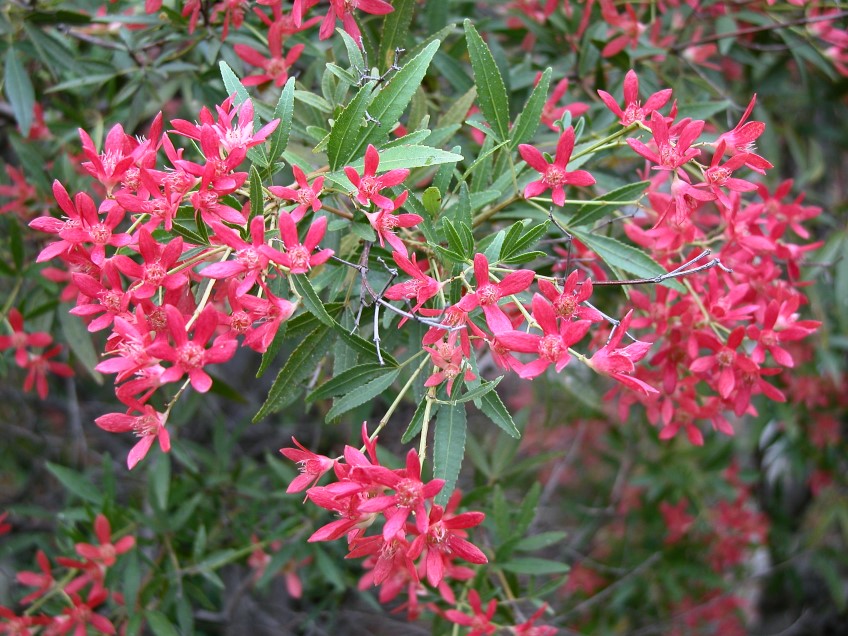
The NSW Christmas Bush, Ceratapetalum Gumiferum.
Blueberry Ash
The blueberry ash, Elaeocarpus reticulatus, is a rainforest shrub which produces blue olive-shaped berries and spectacular bell-shaped,
pink or white flowers that can often appear on the plant together. It is a tall slender shrub or small tree found in rainforest, tall eucalypt forest
and coastal bushland in eastern NSW, south-east Queensland and Victoria. 'Primadonna' is my favourite. It has pink flowers with ruffled edges. You'll
find it at Sydney Wildflower Nursery at
Engadine.
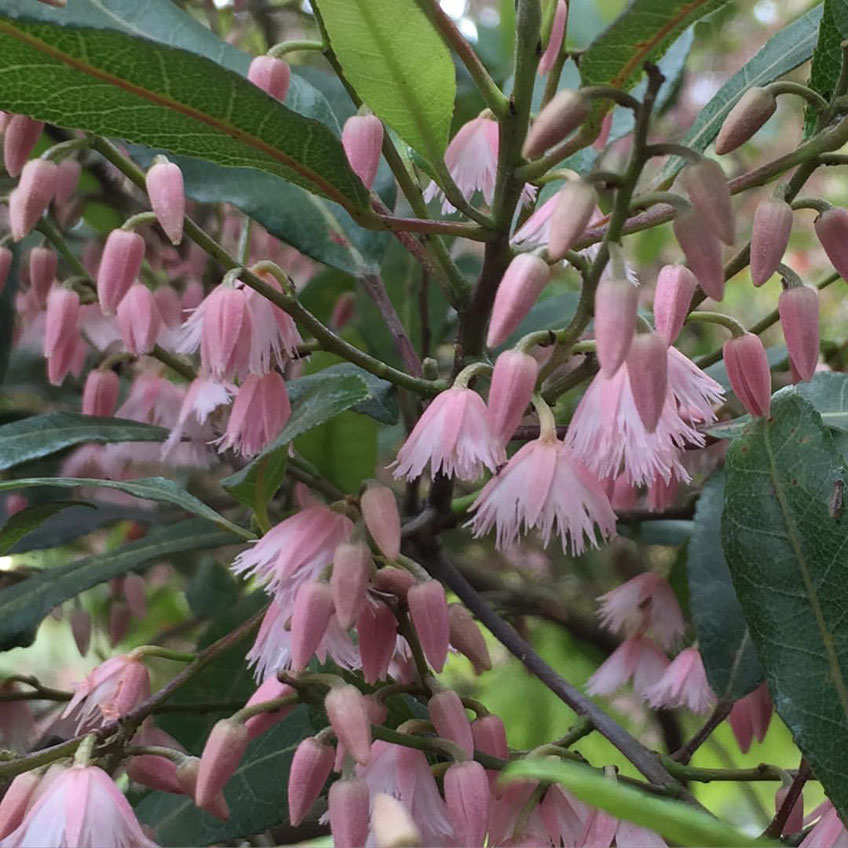
The Blueberry Ash. Photo - David Rose
Size: 5m high x 1.5m wide
Cultivation: Christmas bush will grow in sun or semi-shade, although flowering is best if planted in full sun. Choose a well-drained spot
with reliable moisture. Prune lightly after flowering to keep the bush dense and shapely.
Special comments: Christmas bush can be slow to establish. Ensure the soil around the planting hole is crumbly and that there is minimum
root competition. Feed with a native fertiliser such as Acticote for Natives as soon as growth begins.
Bugwatch:
Red Spider Mite
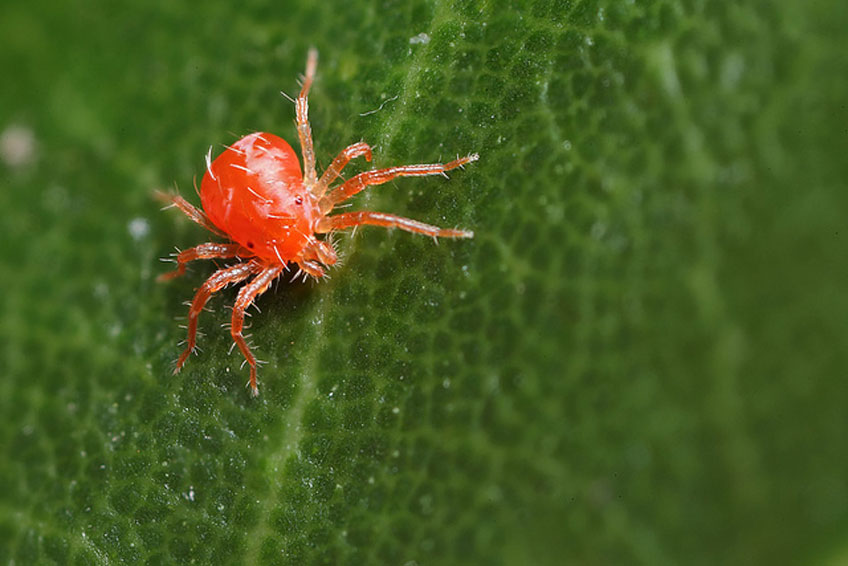
Red Spider Mite. Photo - snakesandspiders.com
Symptoms: tiny insects invisible to the naked eye, but seen as webbing and silvering of new growth. They love plants like Camellias,
Azalias and Rhododendrons. If you grab a magnifying glass you'll see these tiny red spiders moving about.
Treatment: insecticidal potassium soap sprays such as Yates Natures Way Vegie & Herb Spray, a.k.a, Natrasoap, work by blocking the breathing pores and dissolving the scale’s outer covering, causing
dehydration. These treatments will not harm beneficial insects and have a very low toxicity to people and pets. The use of Natrasoap should control
this pest but in the case of severe infestation the use of predatory mites is helpful. Contact Integrated Pest Management. P.O. Box 436 Richmond
NSW 2753. Yates Lime Sulphur is also a useful tool in reducing the population of two-spotted mite, spray onto bare stems after winter pruning.
In The Veggie Patch:
The Tomato Tunnel
Most of your summer veggies are vines, meaning they'll need something to climb on. We made a 2.5m high tunnel with tomato stakes and a roll of light wire
mesh. Plant with climbing beans on one side and climbing tomatoes on the other. Plant tomatoes at 1.5m centres and train them horizontally for maximum
sun exposure. Plant the inside of the tunnel with salad greens.
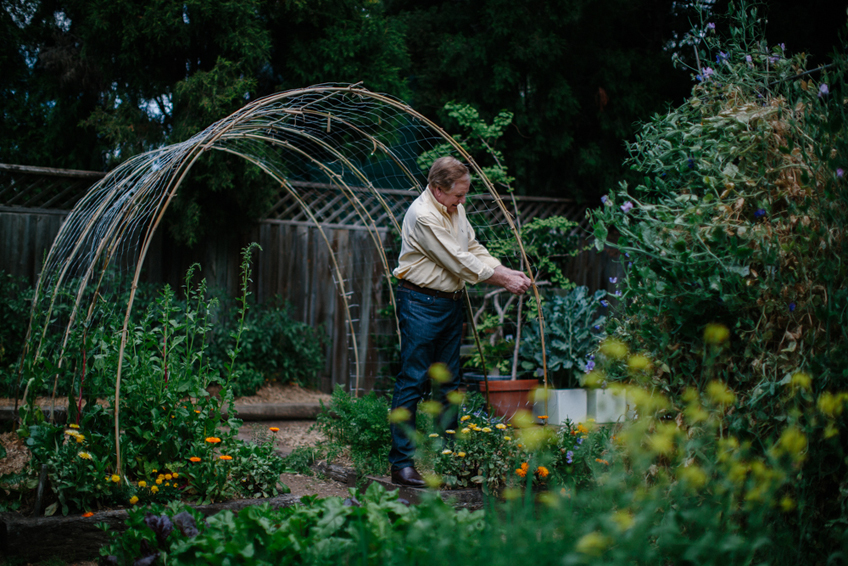
Graham fixing the mesh to the stakes. Our tomato tunnel cost a whole $25! Photo - Luisa Brimble
Garden News:
Yates Nature’s Way Citrus & Ornamental Spray is the newest weapon in the battle of
the bug. It contains a combination of pyrethrin and vegetable oil, boosted with seaweed, which creates a broad spectrum insecticide for controlling
the most common insect pests on citrus, fruit, vegetables and ornamental plants. It is certified with Australian Certified Organic as being suitable
for use in organic gardens, and that means it's OK for edibles!
Trial work conducted in Australia with Yates Nature’s Way Citrus & Ornamental Spray showed that after 6 hours, 98% of bronze orange bugs were dead and after 24 hours, there was 100% control. This means Yates Nature’s Way
Citrus & Ornamental Spray provides an organically certified way for home gardeners to achieve complete control of bronze orange bugs.

The nymph stage of the Bronze Orange Bug. Photo - Andy Burton
Yates Nature’s Way Citrus & Ornamental Spray works via contact, so it is important to spray both upper and lower sides of stems and foliage to maximise
contact of the bugs. Repeat sprays may be required to control bugs not contacted with the initial spray. The variable trigger applicator allows either
a wide spray or a targeted stream, allowing easy spot spraying of individual bugs.
Don't forget to take care around bronze orange bugs as the liquid they squirt can burn eyes and skin, so it’s a good idea to wear glasses, gloves and long
sleeves when spraying for bronze orange bugs.
Callers:
If you were listening to our chat with John about the frangipani, Tequila Sunrise you may like to head down to the North Sydney Markets were you can find
cuttings for sale. Just look out for the Sydney Frangipani Growers stall. Say hi to Joy for me.
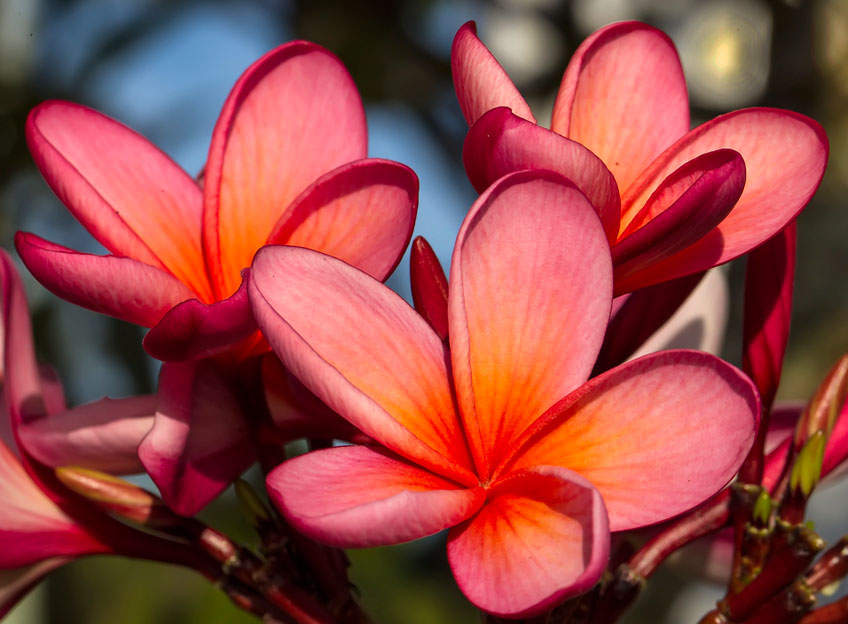
Frangipani 'Tequila Sunrise'
On tour with Garden Clinic:
Ever wanted to run to paradise? We will be heading to Sri Lanka in early 2016 and you can join us. You'll enjoy the tropical beauty of this stunning destination, and the company of our dear friend, Michael Bates,
Landscaper, horticulturist and our new tour leader. Sri Lanka has just about everything a traveler could want like incredible ancient sites, magnificent
scenery, amazing wildlife, delicious cuisine, incredibly friendly and welcoming locals and lovely palm-fringed, white-sand beaches. Add to this a history
touched by Portuguese, Dutch and British influences and a society with a strong and devout adherence to the Buddhist faith and we find an island-nation
of incredibly rich diversity with much to offer. There are only 4 places left on the Sri Lanka tour, so don't wait to long to get your seat. We're
having an information session at the Garden Clinic clubhouse for those joining us on the tour, and you're welcome to attend, so go to the Ross Tours website, or call Royce or Roslyn at Ross Tours.

Sri Lanka is the most unexpected tropical paradise.